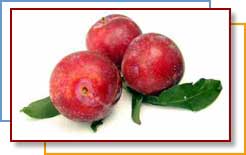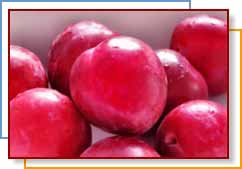
There are more than 140 varieties of plum sold in the United States.
The plum is a drupe—a pitted fruit—related to the nectarine, peach, and
apricot, but it is far more diverse than its relatives, coming in a wider
range of shapes, sizes and especially skin colors. Its flavors also vary
from extremely sweet to quite tart. Some plum varieties are specifically
bred so that they can be dried and still retain their sweetness, and these
are used for prunes. (The Wellness Encyclopedia of Food and Nutrition)
| |
|
Plums |
Serving
Size 1/2 cup, sliced (83g)
|
Amounts
Per Serving |
% Daily
Value |
| Calories
40 |
|
| Calories
from Fat 0 |
|
| Total Fat
0g |
0% |
| Sodium 0mg |
0% |
| Total
Carbohydrate 9g |
3% |
|
Dietary Fiber 1g |
4% |
|
Sugars 8g |
|
| Protein 1g |
|
| Vitamin A |
6% |
| Vitamin C |
15% |
| Calcium |
0% |
| Iron |
0% |
* Percent Daily Values are based on a
2,000 calorie diet. |
|
| |
|
About twenty varieties dominate the commercial supply of plums and most
are either Japanese or European varieties. Japanese are the nonprune plums
or salicina plums. Originally from China, these plums were introduced into
Japan more than 300 years ago. Most varieties have yellow or reddish flesh that
is quite juicy and skin colors that range from crimson to black-red. They
are also clingstone fruits—that is, their flesh clings to the pit. Santa
Rosa and Red Beaut are two of the more popular varieties. Elephant heart
is a large red-fleshed variety that is good for cooking. Plums are also
used for their juice and often jam or a thick syrup is made out of it.
European-type plums are smaller, denser and less juicy than Japanese
varieties; their skin color is always blue or purple and their pits are
usually freestone, meaning they separate easily from the flesh. The flesh
is a golden yellow color. These are the plums made into prunes; a few
varieties are sold fresh and called fresh prunes or purple plums. Among
the better known varieties are Italian, President, Empress, Stanley, and
Tragedy. Damson plums are a small-tart European-type variety used mainly
for preserves.
The domestic plum season extends from May through October, with
Japanese types coming on the market first and peaking in August, followed
by European varieties in the fall.
Good to know: Plums stimulate the bowel movement. Its skin
contains a substance that is responsible for that effect so if you
peel the fruit you won't be bothered with the well-known side effects
of this lovely fruit.
|
Plums should be plump and well colored for their variety. Plums are
usually about 3-6 cm in size. If a fruit yields to gentle pressure, it is
ready to eat, however, you can buy plums that are fairly firm, but not
rock hard and let them soften at home. They will not increase in
sweetness. Ripe plums will be slightly soft at the stem and tip, but watch
out for shriveled skin, mushy spots, or breaks in the skin.
To soften hard plums, place several in a loosely closed paper bag and
leave them at room temperature for a day or two; when softened, transfer
them to the refrigerator. Ripe plums can be refrigerated for up to three
days.
Plums are juiciest at room temperature, but always wash them
before eating or cooking. To pit freestone types, cut the fruit in half,
twist the halves apart, and lift out the pit. To slice or quarter
clingstone plums, use a sharp paring knife and cut through the flesh
towards the pit.
European plums are better than Japanese varieties for cooking. Cooked
plums are usually eaten with the skins on, but if you need to peel them,
first blanch them in boiling water for about 30 seconds.
Baking: Place halved, pitted plums in a baking dish and sprinkle
with sugar and spices to taste. Try adding a few spoonfuls of fruit juice,
instead of water, and cover. Cook until tender, check during baking and add
more liquid, if necessary. Cooking time: about 20 minutes in a 400 degree
oven.
Poaching: Plums can be cooked whole (prick them with a fork first),
halved, or sliced. For serving whole, cook the fruit unpeeled to retain the
shape. Place the fruit in simmering juice, wine, or a mixture of water and
sugar and cook until tender. Cooking time: 3 to 8 minutes (European plums
cook much faster than Japanese plums).
Recipes
 Bruschetta with Plums and Fresh Basil Bruschetta with Plums and Fresh Basil
Makes 12 bruschettas, serving size equals 2
bruschettas
Each serving equals 1/2 cup of fruit or vegetables
Source: California Tree Fruit Agreement/Produce for Better Health
Ingredients
1 sourdough baguette (24 inch)
4 oz reduced fat cream cheese, whipped
6 cups fresh California plums, sliced
1 cup fresh basil
Slice baguette into 24 inch-thick pieces. Toast in a 350-degree F oven
until golden brown. Spread each slice of bread with reduced fat cream
cheese. Slice plums into thin slices. Place several slices of plum on each
piece of bruschetta. Garnish with fresh basil leaf.
Nutritional Analysis: Calories 75, Protein 2g, Carbohydrates 14g, Fat
2g, Calories from Fat 20%, Cholesterol 4mg, Sodium 51mg.

Find more in our
recipe database!
|



